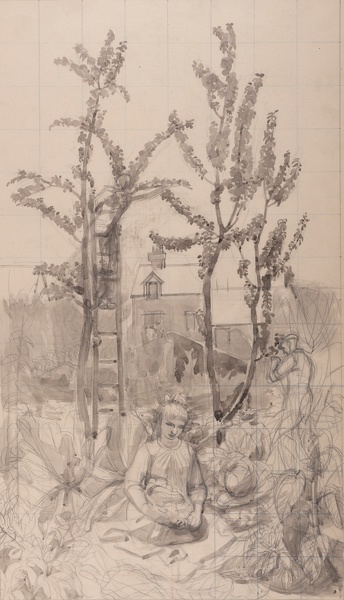
£1,775
Study for Autumn, 1950
Unmounted (ref: 10370)
Pencil and watercolour
Tags: Charles Mahoney pencil watercolour flowers Garden leisure men women work

Pencil and watercolour
Tags: Charles Mahoney pencil watercolour flowers Garden leisure men women work
Provenance: The Artist's Studio
Mahoney was asked to contribute to the Festival of Britain after an initial shortlist of 145 artists was narrowed down to 60. Percy Jowett and John Rothenstein, members of the selection panel, undoubtedly would have recommended him. The exhibition was entitled Sixty paintings for ’51. Works submitted were to be a minimum of 45 x 60 in. The oldest artist asked was W G Gillies (73 at the time), the youngest Lucian Freud (29). Other artists selected included John Armstrong, Edward Burra, Ivon Hitchens, L S Lowry, John Minton, William Scott, Keith Vaughan, Carel Weight and Rodrigo Moynihan (who produced his celebrated portrait group, see ill. ..). Barnett Freedman and Edward Bawden, both also invited, declined.
Mahoney’s contribution was entitled The Garden. Figurative works accounted for approximately half of the contributions submitted and many, like Mahoney’s, were firmly rooted in the British tradition of landscape painting. A full account of the exhibition is given in 25 from 51, 25 Paintings from the Festival of Britain 1951, Sheffield City Art Galleries, 1978
Although not specifically related to the Festival of Britain commission, Autumn was produced during the same period as The Garden and but for a slight difference in height could be described as its pair. The artist’s wife, Dorothy, posed for the main figure. The formal qualities of the Victorian red brick house - which was visible from the platform at Borough Green Station – held a fascination for Mahoney. He frequently travelled from the station to London during the period that he taught at the Royal College of Art.

For drawing, Mahoney liked a textured paper, soft to the touch, such as Ingres, or still better, hand-made papers from firms such as Hayle Mill or Barcham Green. Occasionally he bought cheap sketchbooks from Woolworth’s because he found the paper so sympathetic as a surface for drawing. For his earliest drawings he used mainly B or 2B pencils, but he later preferred Black Prince or carbon pencils. He often used charcoal, adding white or red crayons to highlight drawings. Sometimes he combined these with conté crayons or pastels. For his later drawings he preferred pen and wash, taking great trouble to mix and dilute his inks until he achieved the required tone and colour. His drawing pens were either reservoir nibs in holders or else cartridge pens.